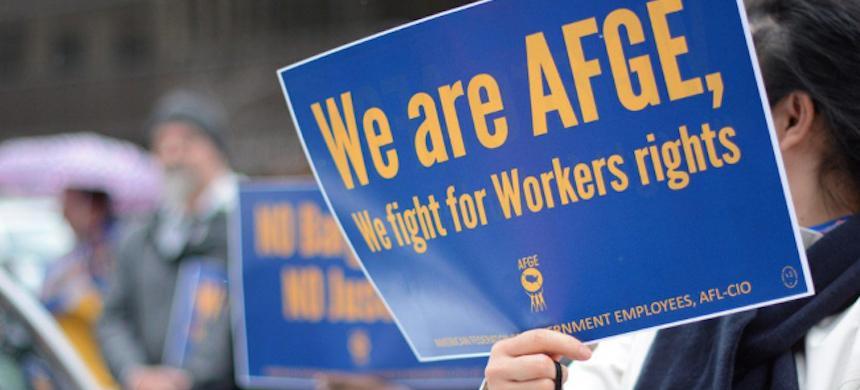Top unions representing federal workers are pondering their next moves after a three-judge panel of the key federal appeals court involved upheld GOP President Trump’s anti-union, anti-worker executive orders.
The practical effect of the 3–0 vote on July 16 by judges of the U.S. Circuit Court of Appeals for D.C.—whose judges decide most cases involving federal agencies—is to reinstate Trump’s edicts, for now, at all federal agencies. A lower court judge had overturned them almost a year ago.
Trump’s chiefs at the departments of Education and Veterans Affairs defied the lower court and implemented Trump’s anti-worker edicts anyway.
Trump’s executive orders are part of his, and the GOP’s, constant war on workers in general and the 2 million federal workers—most of them women, people of color, or both—in particular.
His war includes a pay freeze, a target of getting rid of 10% of all federal workers, arbitrary moves of agencies out of D.C.—giving workers a sudden choice of move or quit—and abolishing the government’s personnel system to reinstitute the graft-ridden corrupt spoils system of the Gilded Age.
AFGE, the largest and lead union in the case, and the other unions still could try to stop Trump by going to the full appeals court and then the U.S. Supreme Court. AFGE President J. David Cox called the judges’ ruling “terrible” and said it upholds Trump’s “union-busting.” He vowed his union would “use every tool available” to fight it.
The judges said the unions followed the wrong path in the first place, by taking the case to U.S. District Court, where Judge Ketanji Brown Jackson ruled for them almost a year ago. She said Trump’s edicts violated federal worker-management law and, because they prevented workers from contacting Congress, the U.S. Constitution, too.
The appeals panel said Jackson shouldn’t have heard the case in the first place. It ruled federal worker-management relations law orders them to take their complaint to the Federal Labor Relations Authority—the federal government’s equivalent of the National Labor Relations Board—first. If they lost there, the unions then could go straight to appeals court.
“Within constitutional bounds, Congress decides what cases the federal courts have jurisdiction to consider,” the judges said. “Congress may preclude district court jurisdiction by establishing an alternative statutory scheme for administrative and judicial review.
That’s what Congress did for cases involving federal workers in conflict with their boss, Trump, the judges said. Go to the FLRA first, they declared—and threw the unions’ case out of court.
Trump’s three executive orders affect all 2 million federal workers, union and nonunion, and sharply restrict their rights on the job. The orders limit subjects of bargaining, let bosses implement rules to fire workers fast and with little right of appeal, throw unions out of their small offices in federal buildings—which reps use to meet with workers over grievances—and deprive them of phones, computers and even paper. And Trump ordered union reps to handle worker grievances on their own time and on their own dime. He also banned workers from calling Congress.
The “terrible decision” by the appeals panel “is a tremendous blow to federal employees and their voice in the workplace,” AFGE’s Cox said. “The decision is mistaken about the jurisdictional question, wrong on the law, and jeopardizes the rights of federal employees across the government. We will fight this decision using every legal tool available to us.”
He also asked Congress to step in to “protect our workplace rights. The union-busting framework laid out in the executive orders and actions already at the bargaining table demonstrate clearly there must be a check on the president’s power to destroy federal employees’ union rights.”
“We lost a court decision today, but one unfair ruling won’t prevent us from keeping up a fight that has gone on for decades, for fair treatment and dignity in federal workplaces,” added Professional and Technical Engineers President Paul Shearon, whose union represents NASA engineers, among others.
